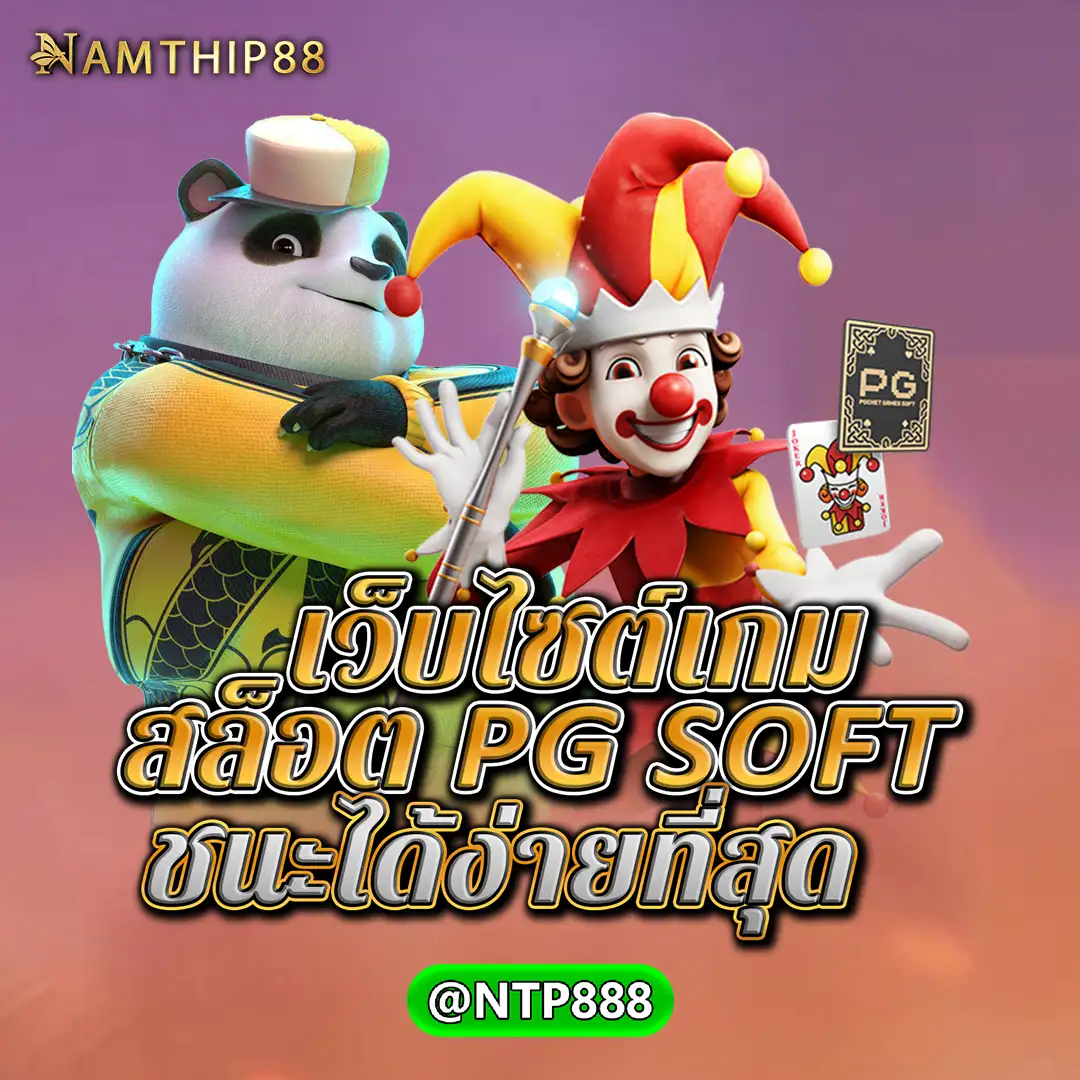หากพูดถึงเกมสล็อตออนไลน์ในยุคนี้ ไม่มีใครไม่รู้จัก PG SLOT ค่ายเกมยอดนิยมที่มาพร้อมกราฟิกสุดอลังการ ระบบเกมทันสมัย และฟีเจอร์ที่เล่นแล้วไม่มีเบื่อ และถ้าคุณเป็นหนึ่งในผู้ที่หลงใหลในการปั่นสล็อต PG แล้วกำลังมองหาเว็บที่มั่นคง ปลอดภัย และมีอัตราแตกที่สูงที่สุด เราขอแนะนำ สล็อตPG Namthip88 เว็บสล็อตคุณภาพที่รวมทุกเกมฮิตของ PG มาไว้ให้คุณในที่เดียว
ไม่ว่าคุณจะเป็นผู้เล่นมือใหม่ หรือมืออาชีพ เว็บนี้ตอบโจทย์ทั้งเรื่องความหลากหลายของเกม ระบบฝากถอนออโต้ ความมั่นคงทางการเงิน และโปรโมชั่นที่ให้มากกว่าเว็บทั่วไป
รู้จักกับ Namthip88 เว็บตรงที่รวมเกม PG โดยเฉพาะ
Namthip88 เป็นเว็บไซต์สล็อตออนไลน์ที่ให้บริการเกมสล็อตจากค่าย PG Soft โดยตรง แบบไม่ผ่านเอเย่นต์ หมดปัญหาเรื่องการโดนล็อกยูส เล่นแล้วไม่จ่าย หรือถอนเงินไม่ได้ เพราะที่นี่การันตีความปลอดภัย จ่ายจริงทุกบิล ไม่ว่าจะยอดเล็กหรือยอดใหญ่
จุดเด่นของ สล็อตPG Namthip88 อยู่ที่การคัดสรรเฉพาะเกม PG ที่แตกง่าย เล่นสนุก และมีค่า RTP สูง มาให้สมาชิกได้เลือกเล่นอย่างจุใจ มีมากกว่า 100 เกม ไม่ว่าจะเป็นแนวผจญภัย แฟนตาซี อาหาร ผลไม้ หรือเทพเจ้า ก็มีครบ

จุดเด่นของเว็บสล็อต Namthip88 ที่ผู้เล่นต้องลอง
-
เว็บตรง ลิขสิทธิ์แท้ ไม่ผ่านเอเย่นต์
หมดปัญหาเรื่องโกงหรือโดนล็อคยูส เพราะทุกเกมใน Namthip88 เป็นเกมจากค่ายตรง ไม่มีการปรับระบบหลังบ้าน เล่นได้เท่าไหร่ ถอนเท่านั้น ไม่มีหักค่าธรรมเนียม -
ระบบฝากถอนออโต้ ภายใน 10 วินาที
Namthip88 ใช้ระบบอัตโนมัติเต็มรูปแบบ รองรับการฝากถอนผ่านบัญชีธนาคารไทยและ TrueMoney Wallet ไม่มีขั้นต่ำ ฝากปุ๊บเล่นได้ทันที ถอนง่าย ไม่ต้องรอแอดมิน -
รวมเกมสล็อตมากกว่า 1,000 เกม
เว็บสล็อต Namthip88 รวบรวมเกมสล็อตจากค่ายชั้นนำไว้มากที่สุดในประเทศไทย ไม่ว่าจะเป็นแนวแฟนตาซี ผจญภัย คลาสสิก ผลไม้ หรือสล็อตแจ็คพอตแตกบ่อย ก็มีให้เลือกเล่นครบ -
รองรับทุกอุปกรณ์ เล่นได้ทุกที่ทุกเวลา
ตัวเว็บไซต์ออกแบบให้รองรับทั้งมือถือ แท็บเล็ต และคอมพิวเตอร์ ไม่ว่าจะเป็น iOS หรือ Android ก็สามารถเข้าถึงได้อย่างง่ายดาย ไม่ต้องดาวน์โหลดแอป -
โปรโมชั่นจัดเต็มทุกวัน
Namthip88 มอบโปรโมชันให้ผู้เล่นอย่างคุ้มค่า เช่น
-
โบนัสสมาชิกใหม่ 100%
-
โปรฝากแรกของวัน
-
คืนยอดเสียรายสัปดาห์
-
โบนัสแนะนำเพื่อน
-
ลุ้นทอง ลุ้นเครดิตฟรีจากกิจกรรมประจำเดือน
แนะนำค่ายเกมยอดนิยมที่เล่นได้ใน Namthip88
PG Soft
ค่ายสล็อตที่ฮิตที่สุดในไทย ด้วยกราฟิกสุดอลังการ ฟีเจอร์ไม่เหมือนใคร และเกมที่โบนัสแตกง่าย เช่น Lucky Neko, Treasures of Aztec, Mahjong Ways 2
Pragmatic Play
เจ้าของเกมดังอย่าง Sweet Bonanza และ Gates of Olympus ที่สามารถซื้อฟรีสปินได้ และมีโบนัสแจกหนักต่อเนื่อง
Joker Gaming & SlotXO
ค่ายเก่าแก่ที่ยังได้รับความนิยมจากผู้เล่นมากมาย โดยเฉพาะเกมอย่าง Roma และ Burning Pearl ที่ขึ้นชื่อเรื่องการจ่ายโบนัสแบบต่อเนื่อง
JILI Slot
ค่ายใหม่มาแรง มีเกมสไตล์แปลกใหม่ เช่น Boxing King, Golden Empire ที่ได้รับการรีวิวว่าเล่นแล้วแตกง่ายจริง
ทำไมต้องเลือกเล่นกับเว็บตรง PG SLOT
การเล่นกับเว็บตรงของ PG SLOT มีข้อดีหลายประการที่ไม่ควรมองข้าม เช่น:
- การเข้าถึงเกมเวอร์ชันแท้ ส่งตรงจากค่าย ไม่ดัดแปลงระบบ RTP
- ระบบฝากถอนออโต้ที่รวดเร็วและแม่นยำ
- ไม่มีค่าธรรมเนียมแฝงในการทำธุรกรรม
- มีกิจกรรมแจกโบนัสและเครดิตฟรีที่โปร่งใส
- การันตีการถอนเงินได้จริง ไม่จำกัดยอด
นอกจากนี้ เว็บตรงยังให้ความสำคัญกับความปลอดภัยของข้อมูลส่วนตัว ด้วยระบบเข้ารหัสขั้นสูง ป้องกันการแฮกหรือการโจรกรรมข้อมูล

จุดเด่นของสล็อต PG ที่ทำให้ผู้เล่นติดใจ
สิ่งที่ทำให้ สล็อต pg แตกต่างจากเกมค่ายอื่น ๆ คือ “ความสร้างสรรค์” ไม่ว่าจะเป็นธีมเกมที่แปลกใหม่ ฟีเจอร์โบนัสที่หลากหลาย และอัตราการชนะที่สูง ซึ่งเป็นปัจจัยสำคัญที่ทำให้ผู้เล่นมีโอกาสรับรางวัลใหญ่อย่างต่อเนื่อง
ตัวอย่างเกมที่ได้รับความนิยม ได้แก่:

Treasures of Aztec หรือที่รู้จักในชื่อสล็อตสาวถ้ำ แตกง่าย มีโหมดโบนัสเข้าบ่อย

Mahjong Ways 2 สล็อตไพ่นกกระจอกที่สามารถเชื่อมต่อคอมโบและรับตัวคูณได้แบบไม่จำกัด

Lucky Neko สล็อตแมวนำโชคที่มาพร้อมฟีเจอร์ตัวคูณ
ผู้ใช้งานจริงพูดถึง สล็อต Namthip88 อย่างไรบ้าง
เสียงตอบรับจากผู้เล่นจริงบนโซเชียลมีเดียและในกลุ่มเกมสล็อตต่าง ๆ มักจะกล่าวถึง สล็อต Namthip88 ในแง่บวก เช่น:
-
“ฝากถอนโคตรไว ไม่ต้องรอให้เสียอารมณ์”
-
“โปรโมชั่นเยอะจริง ได้ใช้ตลอด ไม่ต้องทำเทิร์นยาก”
-
“เกมเยอะจนเลือกไม่ถูก แต่เล่นเกมไหนก็แตกง่ายหมด”
-
“แอดมินดูแลดี ตอบแชทในไม่กี่นาที”
-
“เป็นเว็บที่น่าเล่นสุดในตอนนี้ เล่นแล้วได้ถอนจริงทุกวัน”

เคล็ดลับการเล่นสล็อตกับ Namthip88 ให้ได้กำไร
-
ใช้โหมดทดลองเล่นก่อนลงเงินจริง
เลือกเกมที่คุณสนใจ แล้วลองเล่นดูแนวทางการออกโบนัสก่อน เพื่อเพิ่มโอกาสทำกำไรจริง -
ไม่วางเดิมพันสูงเกินไปตั้งแต่ต้น
เริ่มจากเบทต่ำเพื่อจับจังหวะของเกม เมื่อมั่นใจว่าเกมกำลังแจกค่อยเพิ่มเงินเดิมพัน -
เลือกเล่นเกมที่มี RTP สูงกว่า 96%
เพราะเกมเหล่านี้จะมีอัตราการจ่ายคืนผู้เล่นที่ดีกว่าในระยะยาว -
รับโปรโมชั่นให้เหมาะกับช่วงเวลา
เช่น ฝากตอนเช้ารับโบนัสเพิ่ม หรือคืนยอดเสียทุกวันจันทร์

โปรโมชั่นสุดคุ้มจาก Namthip88 ที่คุณไม่ควรพลาด
สล็อตเว็บตรง Namthip88 มีโปรโมชั่นที่ออกแบบมาเพื่อตอบโจทย์ผู้เล่นทุกประเภท ไม่ว่าจะเป็นสายทุนน้อยหรือสายหนัก ก็มีสิทธิ์รับโบนัสและของรางวัลได้เช่นกัน เช่น
-
โปรสมาชิกใหม่ 100%
ฝากครั้งแรก รับโบนัสเพิ่มทันที เทิร์นต่ำ ถอนได้ไม่อั้น -
ฝากประจำรับโบนัสทุกวัน
ฝากรายวันครบตามกำหนด รับโบนัสสะสมเพิ่มอีกเรื่อย ๆ -
คืนยอดเสียทุกสัปดาห์ 10%
ไม่ว่าจะแพ้หรือเสีย ยังมีเงินคืนให้นำไปแก้มือได้อีก -
แนะนำเพื่อน รับทันทีเครดิตฟรี
ชวนเพื่อนมาเล่น รับค่าคอมมิชชั่นแบบรายวัน ไม่จำกัดจำนวน

เหตุผลที่ต้องเล่นสล็อต PG กับ Namthip88
ในตลาดที่มีเว็บสล็อตเปิดใหม่มากมาย ทำไมผู้เล่นจึงเลือก PG สล็อต Namthip88 เป็นแหล่งทำกำไรประจำวัน? คำตอบคือ “คุณภาพที่แตกต่างอย่างเห็นได้ชัด” ดังนี้:
1. เว็บตรงลิขสิทธิ์แท้ ไม่ผ่านเอเย่นต์
Namthip88 ให้บริการเกมสล็อตจาก PG โดยตรง ส่งตรงจากเซิร์ฟเวอร์แท้ ไม่มีปรับเรท ไม่มีล็อคยูส ทำให้ผู้เล่นมั่นใจได้ว่าทุกการเดิมพันมีโอกาสชนะจริง
2. ฝาก-ถอนออโต้ รวดเร็วทันใจ
ระบบอัตโนมัติของ Namthip88 รองรับทั้งธนาคารไทยและ TrueMoney Wallet ฝาก-ถอนใช้เวลาไม่เกิน 10 วินาที ไม่ต้องรอแอดมิน ไม่ต้องแจ้งสลิป
3. รวมเกม PG ครบทุกเกม อัปเดตไว
ไม่ว่าจะเป็นเกมฮิตอย่าง Mahjong Ways, Lucky Neko, Treasures of Aztec หรือเกมใหม่ล่าสุดอย่าง Mystical Spirits, Fortune Rabbit Namthip88 มีให้เลือกเล่นครบ และอัปเดตทันทีที่ค่ายปล่อยเกมใหม่
4. โปรโมชั่นจัดหนัก สำหรับสายพีจีโดยเฉพาะ
Namthip88 มีโปรโมชันที่ออกแบบมาให้เหมาะกับผู้เล่นสล็อต PG เช่น:
-
โบนัสฝากแรก 100%
-
โบนัสเติมเงินรายวัน
-
คืนยอดเสียสูงสุด 10%
-
สะสมแต้มแลกเครดิตฟรี
5. ทดลองเล่นฟรี ไม่จำกัด
อยากลองเกมใหม่แต่ยังไม่กล้าเติมเงิน? Namthip88 เปิดให้ ทดลองเล่นสล็อต PG ฟรี ทุกเกมโดยไม่ต้องสมัครสมาชิก ลองก่อน ค่อยตัดสินใจจริงได้เลย
เทคนิคเล่นสล็อต PG ที่ Namthip88 ให้ได้กำไร
-
เลือกเกม RTP สูง: ค่า RTP ของเกม PG ส่วนใหญ่เกิน 96% แต่อย่าลืมเลือกเกมที่คนรีวิวว่าแตกง่ายจริง
-
ตั้งงบและเป้าในแต่ละวัน: อย่าเล่นเกินงบ และรู้ว่าเมื่อไรควรหยุด
-
ใช้โปรให้คุ้ม: เช่น ฝากเช้า รับโบนัสเพิ่ม หรือฝากประจำสะสมแต้ม
-
เปลี่ยนเกมหากเกมเดิมไม่แจก: หากหมุนไป 50-70 ครั้งแล้วยังไม่เข้าโบนัส ให้ลองสลับเกม
-
เล่นในช่วงเวลาที่คนออนไลน์น้อย: เช่น หลังเที่ยงคืนหรือเช้าตรู่ ซึ่งมักจะมีอัตราแจกที่ดีขึ้น
สรุป
หากคุณกำลังมองหาเว็บที่รวมเกมสล็อต PG ไว้อย่างครบครัน แตกง่าย จ่ายจริง ระบบเสถียร และโปรโมชั่นคุ้มค่า สล็อต PG namthip88 คือเว็บที่ตอบโจทย์ทุกความต้องการของนักเล่นสล็อตในปี 2025 นี้
ด้วยการเป็นเว็บตรง ระบบฝากถอนออโต้ รวมเกมคุณภาพสูง และการดูแลผู้เล่นระดับมืออาชีพ Namthip88 จึงได้รับความไว้วางใจจากผู้เล่นทั่วประเทศ
สมัครเลยวันนี้ รับโบนัสพิเศษทันที และเริ่มล่าแจ็คพอตใหญ่กับสล็อตพีจีได้ทุกวัน ทุกเวลา บนเว็บคุณภาพที่ผู้เล่นจริงแนะนำ!
FAQs คำถามที่พบบ่อย
เว็บสล็อต PG เว็บตรงแท้เป็นเว็บไซต์ที่ให้บริการโดยตรงจากค่าย PG SLOT โดยไม่ผ่านเอเย่นต์ ซึ่งหมายความว่าผู้เล่นจะได้รับอัตราการจ่ายที่ยุติธรรม ไม่มีการปรับลดเปอร์เซ็นต์ชนะ และมีระบบฝาก-ถอนที่รวดเร็วและปลอดภัยกว่าเว็บเอเย่นต์ทั่วไป
PG SLOT มีเกมที่แตกหนักและให้โบนัสสูงมากมาย เช่น
-
Caishen Wins – เกมเทพเจ้าจีนที่มาพร้อมกับตัวคูณมหาศาล
-
Mahjong Ways 2 – เกมไพ่นกกระจอกที่มีฟีเจอร์ตัวคูณเพิ่มขึ้นเรื่อย ๆ
-
Treasures of Aztec – เกมสาวถ้ำยอดนิยมที่มีโบนัสแตกบ่อย
ผู้เล่นสามารถทดลองเล่นและเลือกเกมที่เหมาะกับสไตล์การเล่นของตัวเองได้
เว็บสล็อต PG เว็บตรงแท้มาพร้อมระบบฝาก-ถอนอัตโนมัติ ที่สามารถทำธุรกรรมได้ภายในไม่กี่วินาที รองรับการฝากผ่านธนาคารชั้นนำและ True Wallet เพื่อความสะดวกของผู้เล่น และไม่มีขั้นต่ำในการฝากหรือถอน
เว็บตรงแท้มักจะมีโปรโมชั่นพิเศษ เช่น
-
โบนัสต้อนรับสมาชิกใหม่ รับเครดิตฟรีเมื่อลงทะเบียน
-
โบนัสฝากเงิน เพิ่มเครดิตให้เมื่อฝากเงินครั้งแรกของวัน
-
คืนยอดเสีย สำหรับผู้เล่นที่เล่นแล้วไม่ชนะ สามารถรับเงินคืนได้บางส่วน
-
แนะนำเพื่อน รับค่าคอมมิชชันจากเพื่อนที่สมัครผ่านลิงก์ของคุณ
เว็บสล็อต PG เว็บตรงแท้มีมาตรฐานความปลอดภัยระดับสูง ใช้ระบบ SSL ในการปกป้องข้อมูลของผู้เล่น และได้รับใบอนุญาตจากองค์กรเกมระดับสากล ทำให้มั่นใจได้ว่าการเล่นเกมสล็อตที่นี่ปลอดภัย ไม่มีการโกง






